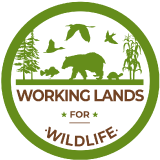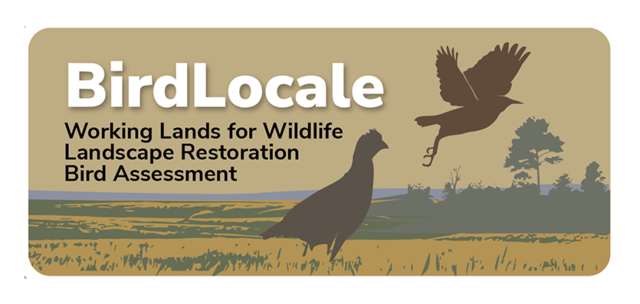-
 Quail Forever
Quail Forever
-
by
Web Editor
—
published
Jun 13, 2019
—
last modified
Apr 21, 2023 12:40 AM
—
filed under:
Partners,
Wildlife,
Foraging,
WLFW,
NGO,
Northern Bobwhite Quail,
Birds,
Conservation,
Quail Forever,
QF,
Grasslands and Savannas,
Working Lands for Wildlife,
Native Grasslands,
Pine Savanna
Quail Forever is dedicated to the conservation of quail, pheasants and other wildlife through habitat improvements, public awareness, education, and land management policies and programs.
Located in
LP Members
/
Organizations Search
-
 Quail habitat also protects threatened orchid species in Tennessee
Quail habitat also protects threatened orchid species in Tennessee
-
by
Rachel Holt
—
published
May 26, 2025
—
last modified
May 27, 2025 01:39 PM
—
filed under:
WLFW,
Northern Bobwhite Quail,
Grasslands and Savannas,
Orchid,
Working Lands for Wildlife,
Tennessee,
Northern Bobwhite Quail, Grasslands & Savannas
Two rare species were recently found on working lands in Van Buren County
Located in
Stories
-
 Reconnecting Cattle and Quail
Reconnecting Cattle and Quail
-
by
Admin
—
published
May 06, 2021
—
filed under:
WLFW,
Livestock,
Northern Bobwhite Quail,
Instructional Video,
Landowners,
Video,
Cattle,
Working Lands for Wildlife,
Landowner Information,
Grazing,
Native Grasslands
Learn about the Working Lands for Wildlife program and work in Ohio between USDA-NRCS and local farmers and ranchers. Grazing cattle on warm season, native grasses is great for cattle as well as critical species like the Northern Bobwhite Quail. Video for landowners and cattle producers.
Presented by Nick Schell (USDA-NRCS Ohio) and Dr. Pat Keyser (UT - Center for Native Grasslands Management) at the Ohio Forage and Grassland Council Conference in 2017.
Located in
Learning & Tech Transfer
/
Webinars & Videos
-
 Regenerative Agriculture: No-Till Farming
Regenerative Agriculture: No-Till Farming
-
by
Admin
—
published
Dec 30, 2020
—
last modified
Apr 21, 2023 02:04 PM
—
filed under:
Regenerative Agriculture,
Climate Impacts,
WLFW,
Livestock,
Webinars and Instructional Videos,
Northern Bobwhite Quail,
Training Resources,
Video,
Working Lands for Wildlife,
Grasslands and Savannas,
Ranching,
Farming,
Agriculture,
Grazing
Gabe Brown, legendary Rancher from Bismarck, North Dakota, discusses how Regenerative Agriculture is a solution to local and global challenges.
Located in
Training Resources
/
Webinars and Instructional Videos
-
 Residue & Tillage Management for Wildlife (KY)
Residue & Tillage Management for Wildlife (KY)
-
by
Bridgett Costanzo
—
published
Mar 12, 2021
—
last modified
Apr 21, 2023 12:12 AM
—
filed under:
Information,
WLFW,
wildilfe,
Northern Bobwhite Quail,
cropland,
job sheet,
till,
tillage,
NRCS,
Grasslands and Savannas,
Working Lands for Wildlife,
NRCS Conservation Practices & Materials,
Job Sheets
Job sheet
Located in
Information
/
NRCS Conservation Practices & Materials
/
Job Sheets
-
 Restoring Upland Habitat in Arkansas' Grand Prairie
Restoring Upland Habitat in Arkansas' Grand Prairie
-
by
Gilbert Randolph
—
published
Jan 09, 2025
—
last modified
May 27, 2025 05:42 AM
—
filed under:
Working Lands for Wildlife,
Working Lands,
Grasslands and Savannas,
Stories
The Holmes farm, located in Prairie County Arkansas has been in the family for over 100 years and it sits in a quail focal area and right on the border of Arkansas’ Grand Prairie.
Located in
Stories
-
 Sagebrush Biome Framework
Sagebrush Biome Framework
-
by
Web Editor
—
published
Jun 25, 2023
—
filed under:
Resources,
Working Lands for Wildlife,
WLFW,
Working Lands for Wildlife West,
NRCS
This framework for 2021-2025 reflects collaborative, multi-state planning efforts to update SGI 2.0, and continues to build from a decade of success conserving the sagebrush biome. This framework also serves as NRCS’ ongoing contribution to the Sagebrush Conservation Strategy administered by Western Association of Fish and Wildlife Agencies. Sharing common cross-boundary threats, NRCS staff across eleven western states collaborated to create this shared vision for conservation action.
Located in
Resources
-
SE CASC Science Seminar, January 22: New Project Lightning Talks
-
by
Web Editor
—
published
Jan 13, 2025
—
last modified
Jan 13, 2025 05:42 PM
—
filed under:
WLFW,
News & Events,
Science Seminar Series,
SECASC,
News,
Working Lands for Wildlife,
Events
Join us for a series of 5-minute talks summarizing newly funded SE CASC projects.
Located in
News & Announcements
/
Events
/
WLFW Events Inbox
-
SE CASC Webinar-Integrating Sea Level Rise Scenarios into Everglades Restoration Planning
-
by
Web Editor
—
published
Jun 06, 2025
—
filed under:
WLFW,
News & Events,
Southeast Climate Adaptation Science Center,
SECASC,
News,
Working Lands for Wildlife,
Events
June 18 | 1pm ET | Zoom
Located in
News & Announcements
/
WLFW News Inbox
-
SECAS December 2024 Newsletter
-
by
Web Editor
—
published
Dec 20, 2024
—
filed under:
Newsletter,
WLFW,
News & Events,
News,
SECAS,
Southeast Conservation Adaptation Strategy,
Working Lands for Wildlife
Web forums require registration in the new year, plan for the 2025 Blueprint update
Located in
News & Announcements
/
WLFW Newsletters
/
Southeast Conservation Adaptation Strategy (SECAS) Newsletter


